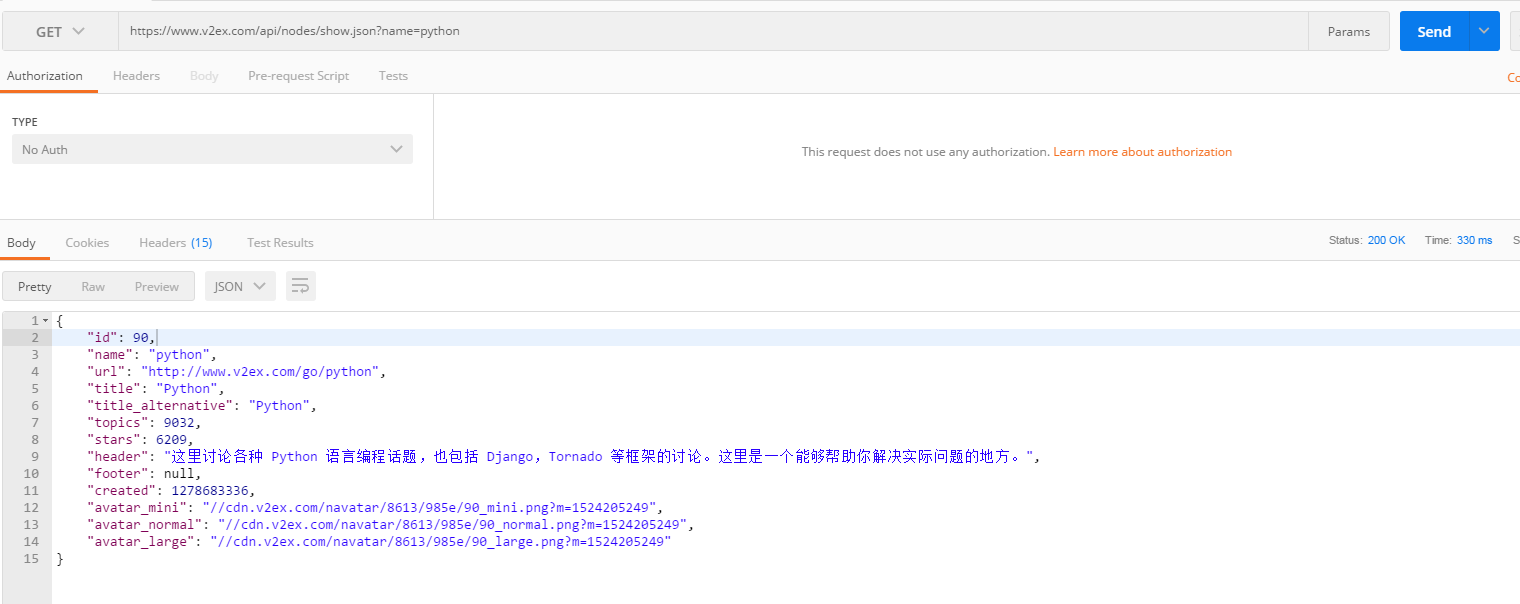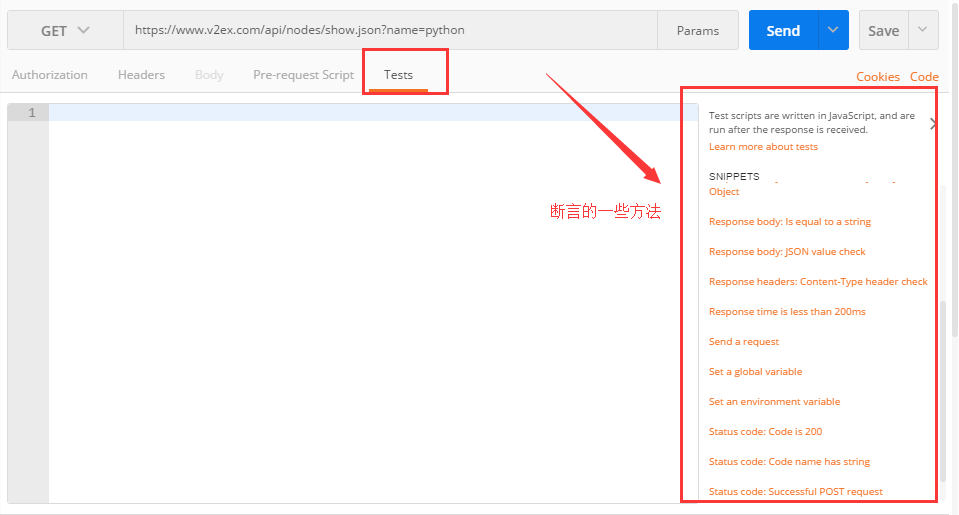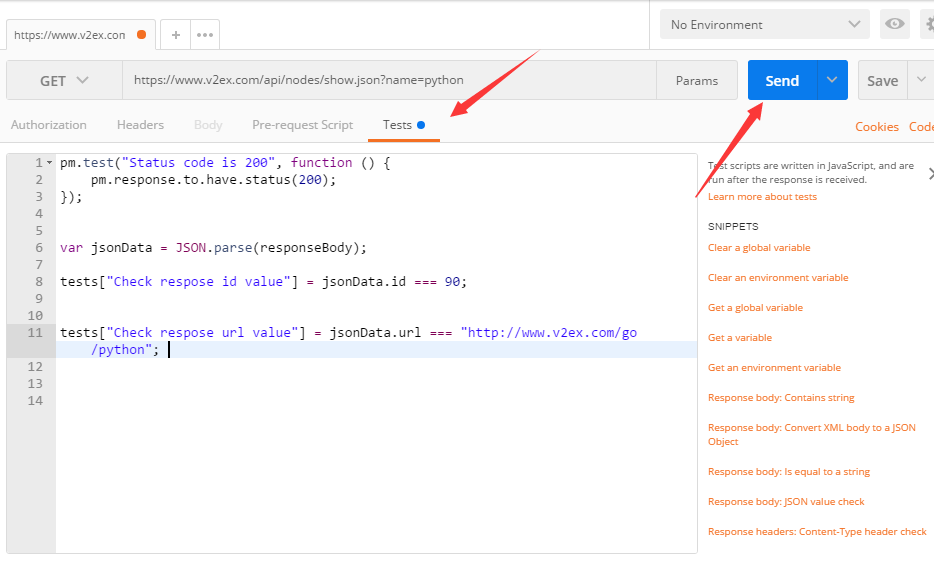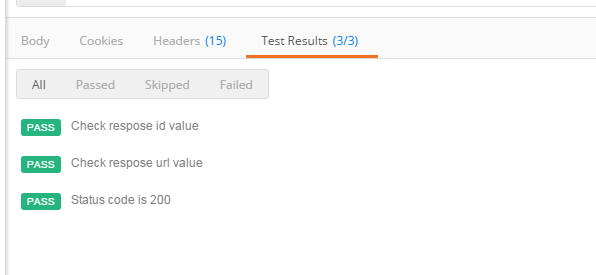推荐我的另一篇文章
浅谈JSONObject解析JSON数据,这篇文章原理类似,使用java或者beanshell进行断言解析json数据
介绍断言之前,我们先测试1个接口:
接口地址:https://www.v2ex.com/api/nodes/show.json?name=python
- Method: GET
- Authentication: None

做测试的同学,我相信每个人都知道断言,就是结果和预期对比,如果一致,则用例通过,如果不一致,断言失败,用例失败。那么上面这个接口我们如何用postman来进行断言呢?也很简单,用到postman tests 这个模块。

那么上面的接口我们如何断言呢?很简单,从响应内容做断言。比如我们可以断言 id=90,url = "http://www.v2ex.com/go/python",状态码等于200
我们在tests输入框填写:
pm.test("Status code is 200", function () {
pm.response.to.have.status(200);
}); //断言状态码是200
var jsonData = JSON.parse(responseBody);
tests["Check respose id value"] = jsonData.id === 90; //断言id是90
tests["Check respose url value"] = jsonData.url === "http://www.v2ex.com/go/python"; //断言url
操作步骤:1、填写断言 2、点击send

查看断言结果:

当然上面断言是比较简单的断言,如果返回的数据如下所示,我们应该如何断言呢?
{
"status": 1,
"message": "success",
"data": [
{
"id": 1,
"title": "乡愁",
"author": "余光中",
"content": "小时候,乡愁是一枚小小的邮票,我在这头,母亲在那头。长大后,乡愁是一张窄窄的船票,我在这头,新娘在那头"
},
{
"id": 5,
"title": "乡愁",
"author": "余光中",
"content": "小时候,乡愁是一枚小小的邮票,我在这头,母亲在那头。长大后,乡愁是一张窄窄的船票,我在这头,新娘在那头"
}
]
}
跟上面断言不同的是,data里面可能有多个json格式的数据,如果我们想断言data里面第一个json应该如何断言呢?其实也非常简单,我们在tests输入框填写:
var jsonData = JSON.parse(responseBody); tests["Check respose status value"] = jsonData.status === 1; pm.test("判断data里面第一个json数据的id为1", function () { var jsonData = pm.response.json(); pm.expect(jsonData.data[0].id).to.eql(1);});

postman常见断言方法介绍:
Setting an environment variable (设置一个环境变量)
pm.environment.set("variable_key", "variable_value");
Setting a nested object as an environment variable (将嵌套对象设置为环境变量)
var array = [1, 2, 3, 4];
pm.environment.set("array", JSON.stringify(array, null, 2));
var obj = { a: [1, 2, 3, 4], b: { c: 'val' } };
pm.environment.set("obj", JSON.stringify(obj));
Getting an environment variable (获取环境变量)
pm.environment.get("variable_key");
Getting an environment variable (whose value is a stringified object) 获取一个环境变量(其值是一个字符串化的对象)
// These statements should be wrapped in a try-catch block if the data is coming from an unknown source.
var array = JSON.parse(pm.environment.get("array"));
var obj = JSON.parse(pm.environment.get("obj"));
Clear an environment variable (清除一个环境变量)
pm.environment.unset("variable_key");
Set a global variable (设置一个全局变量)
pm.globals.set("variable_key", "variable_value");
Get a global variable (获取一个全局变量)
pm.globals.get("variable_key");
Clear a global variable (清除全局变量)
pm.globals.unset("variable_key");
Get a variable (获取一个变量)
该函数在全局变量和活动环境中搜索变量。
pm.variables.get("variable_key");
Check if response body contains a string (检查响应主体是否包含字符串)
pm.test("Body matches string", function () {
pm.expect(pm.response.text()).to.include("string_you_want_to_search");
});
Check if response body is equal to a string (检查响应主体是否等于一个字符串)
pm.test("Body is correct", function () {
pm.response.to.have.body("response_body_string");
});
Check for a JSON value (检查JSON值)
pm.test("Your test name", function () {
var jsonData = pm.response.json();
pm.expect(jsonData.value).to.eql(100);
});
Content-Type is present (内容类型存在)
pm.test("Content-Type is present", function () {
pm.response.to.have.header("Content-Type");
});
Response time is less than 200ms (响应时间小于200ms)
pm.test("Response time is less than 200ms", function () {
pm.expect(pm.response.responseTime).to.be.below(200);
});
Status code is 200 (状态码是200)
pm.test("Status code is 200", function () {
pm.response.to.have.status(200);
});
Code name contains a string (代码名称包含一个字符串)
pm.test("Status code name has string", function () {
pm.response.to.have.status("Created");
});
Successful POST request status code (成功的POST请求状态码)
pm.test("Successful POST request", function () {
pm.expect(pm.response.code).to.be.oneOf([201,202]);
});
Use TinyValidator for JSON data (对于JSON数据使用TinyValidator)
var schema = {
"items": {
"type": "boolean"
}
};
var data1 = [true, false];
var data2 = [true, 123];
pm.test('Schema is valid', function() {
pm.expect(tv4.validate(data1, schema)).to.be.true;
pm.expect(tv4.validate(data2, schema)).to.be.true;
});
Decode base64 encoded data (解码base64编码的数据)
var intermediate,
base64Content, // assume this has a base64 encoded value
rawContent = base64Content.slice('data:application/octet-stream;base64,'.length);
intermediate = CryptoJS.enc.Base64.parse(base64content); // CryptoJS is an inbuilt object, documented here: https://www.npmjs.com/package/crypto-js
pm.test('Contents are valid', function() {
pm.expect(CryptoJS.enc.Utf8.stringify(intermediate)).to.be.true; // a check for non-emptiness
});
Send an asynchronous request (发送异步请求)
该功能既可以作为预先请求,也可以作为测试脚本使用。
pm.sendRequest("https://postman-echo.com/get", function (err, response) {
console.log(response.json());
});
Convert XML body to a JSON object (将XML正文转换为JSON对象)
var jsonObject = xml2Json(responseBody);